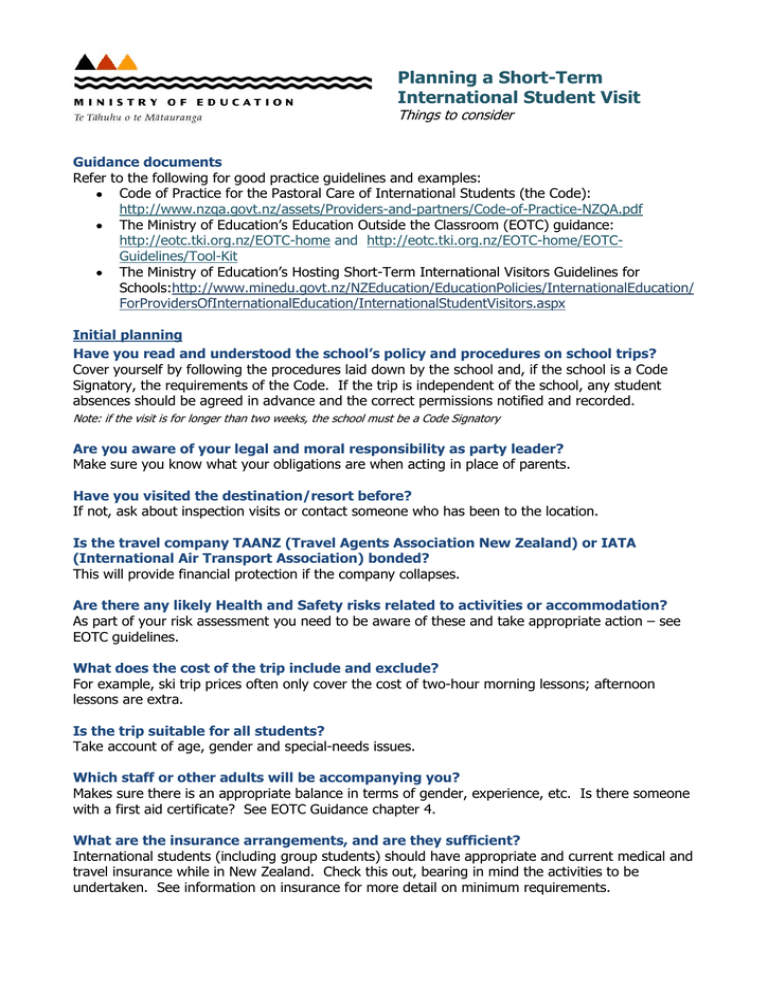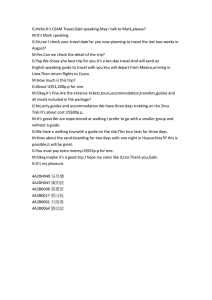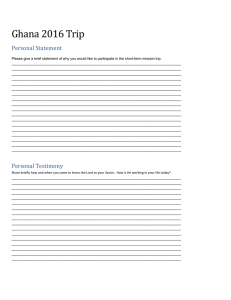Planning a Short-Term International Student Visit
advertisement

Planning a Short-Term International Student Visit Things to consider Guidance documents Refer to the following for good practice guidelines and examples: Code of Practice for the Pastoral Care of International Students (the Code): http://www.nzqa.govt.nz/assets/Providers-and-partners/Code-of-Practice-NZQA.pdf The Ministry of Education’s Education Outside the Classroom (EOTC) guidance: http://eotc.tki.org.nz/EOTC-home and http://eotc.tki.org.nz/EOTC-home/EOTCGuidelines/Tool-Kit The Ministry of Education’s Hosting Short-Term International Visitors Guidelines for Schools:http://www.minedu.govt.nz/NZEducation/EducationPolicies/InternationalEducation/ ForProvidersOfInternationalEducation/InternationalStudentVisitors.aspx Initial planning Have you read and understood the school’s policy and procedures on school trips? Cover yourself by following the procedures laid down by the school and, if the school is a Code Signatory, the requirements of the Code. If the trip is independent of the school, any student absences should be agreed in advance and the correct permissions notified and recorded. Note: if the visit is for longer than two weeks, the school must be a Code Signatory Are you aware of your legal and moral responsibility as party leader? Make sure you know what your obligations are when acting in place of parents. Have you visited the destination/resort before? If not, ask about inspection visits or contact someone who has been to the location. Is the travel company TAANZ (Travel Agents Association New Zealand) or IATA (International Air Transport Association) bonded? This will provide financial protection if the company collapses. Are there any likely Health and Safety risks related to activities or accommodation? As part of your risk assessment you need to be aware of these and take appropriate action – see EOTC guidelines. What does the cost of the trip include and exclude? For example, ski trip prices often only cover the cost of two-hour morning lessons; afternoon lessons are extra. Is the trip suitable for all students? Take account of age, gender and special-needs issues. Which staff or other adults will be accompanying you? Makes sure there is an appropriate balance in terms of gender, experience, etc. Is there someone with a first aid certificate? See EOTC Guidance chapter 4. What are the insurance arrangements, and are they sufficient? International students (including group students) should have appropriate and current medical and travel insurance while in New Zealand. Check this out, bearing in mind the activities to be undertaken. See information on insurance for more detail on minimum requirements. What is the payment schedule? Provide a trip-payments record card for each student, and keep a computerised record of payments in and out. Are there any passport/visa implications? There may be students whose nationality status may affect their ability to travel abroad. Inbound students who are in New Zealand holding a Visitor Visa can go to any school for up to two weeks as long as the school is not receiving money for the visit. They don’t have to pay any [school] fees, and they are not entered on ENROL because they are just visiting. The school must keep a separate record of their details Implementing the plan Write to parents including the following information: Details of staff/adults accompanying the trip Payment schedule and amounts, including a clear indication that deposits are nonreturnable Details of what is, and what is not, covered by the cost Advice on appropriate clothing and pocket money The itinerary, including departure and arrival details Accommodation details A clear identification of possible risks A clear statement concerning discipline and appropriate sanctions Details of travel arrangements, including any en route accommodation Date of any parents’ information evening Emergency contact name and number both at home and away A form of consent requesting special medical and diet information, and permission to take appropriate emergency measures, plus home contact numbers Request for nationality and passport details Medical and travel insurance requirements Have regular team meetings and ensure all staff are consulted about arrangements Team work and leadership are vital ingredients for a successful trip. Regularly update your risk assessment relating to individual students’ needs Meet with relevant staff and parents if you are concerned about an individual student’s needs. For example, an additional member of staff might be needed to assist with a student who is disable or has particular behavioural difficulties. During the trip Regularly do a headcount of students, particularly when getting on and off transport Always get another member of staff to check Ensure reasonable supervision at all times. Allocate groups of students to individual staff members; this helps rapid communication of information Ensure students understand and apply travel safety requirements, eg using seat belts on coaches Create positive relationships with coach drivers, hotel managers, tour reps and, above all, teachers from other schools! Always keep students informed of reasons for delays or sudden changes of plan. This will keep most students quiet for a period of time On arrival at the accommodation update your risk assessment. Consider a fire practice, and check entries and exits to rooms Take care when allocating students to rooms. There needs to be a balance between students’ preferences and the need to ensure good order and safety Take similar care in allocating staff members Advise students to take care of their belongings and offer to lock valuables in staff rooms or in the hotel safe Make sure rooms are checked for pre-existing damage and report it to the accommodation manager Arrange a meeting with students to reinforce the code of conduct, identify out-of-bounds areas, map out the programme for the week and agree on bedtimes Let the tour reps or hotel managers know of any concerns you may have, particularly if you think they compromise student safety Do not change the planned programme, or accept enforced changes, without good reason Consider the insurance implications of any change your liability as a party leader Before setting off for home from abroad ensure students are aware of Customs and Biosecurity requirements, and the penalties that underpin them On the way home ensure that, in the last stages of the journey, students can contact home to provide an expected time of arrival On arrival, staff must stay with students until they are collected Contact the parents if they are late If you are unsure how to deal with a problem on the trip, consult your team and don’t be too proud to contact your school for advice. A school should ideally provide a mobile phone so that you can make contact in the event of an emergency. Insurance Insurance should, at a minimum, cover the following aspects: Health cover while in New Zealand medical expenses incurred for the treatment of illness and/or injury (in excess of New Zealand Accident Compensation Corporation (ACC) cover) that requires surgery and/or hospitalisation – unlimited sum insured medical evacuation related to serious illness and injuries – unlimited sum insured emergency dental treatment costs for family members’ travel in the event that the student suffers a serious illness or injury. Repatriation, search and rescue repatriation and expatriation in the event a student has to return home following an injury or illness which interrupts their study plans return of mortal remains/funeral expenses - including travel costs for family members, repatriation of remains and funeral costs, search-and-rescue operation costs incurred to locate the insured. Travel into and out of New Zealand missed flights or delays for travel into and out of New Zealand medical expenses incurred for the treatment of an illness and injury incurred during the travel. Personal liability negligence causing bodily injury (including death) of another person or loss of or damage to property false arrest and wrongful detention. Ratios see EOTC guidelines, Chapter 4 A ratio compares the number of skilled and experienced supervisors to the number of students or participants involved in an event. Ratios will vary according to the age and needs of students, the nature of the activity, the location, the competence of the students and the staff involved. Ratios for overseas trips, remote environments or hazardous activities should match the increased level of risk involved. Temporary accommodation Trip organisers must take a robust approach to determine that temporary accommodation and accompanying supervision are suitable, including, but not limited to: Assessment of the suitability Ensuring that students under 18 have appropriate supervision Ensuring the group students have an appropriate ratio of supervisors Monitoring and managing any risks to the safety of students. For further information on hosting fee-paying international students please go to: http://www.minedu.govt.nz/NZEducation/EducationPolicies/InternationalEducation.aspx http://www.nzqa.govt.nz/studying-in-new-zealand/code-of-practice-for-the-pastoral-careof-international-students/ For further information on organising regular group exchanges please visit: http://www.minedu.govt.nz/NZEducation/EducationPolicies/InternationalEducation/ForProvi dersOfInternationalEducation/StudentExchangeApprovals.aspx For further information about how to conduct a risk assessment – these will need to be adapted for the NZ environment, but provide a good introduction: - Demystifying Risk Assessment http://www.schooltravelforum.com/white-papers-guides Disclaimer These guidance notes have been compiled for your information only and should not be treated as an exhaustive statement on the subject. Nor should they be considered as a substitute for legal or professional service. The information is provided on the basis that you are responsible for making your own assessment of the topics discussed. The Ministry expressly disclaims all liability (including but not limited to liability for negligence) for errors or omissions of any kind whatsoever or for any loss (including direct and indirect losses), damages or other consequences which may arise from your reliance on the material contained in the guidance notes.

